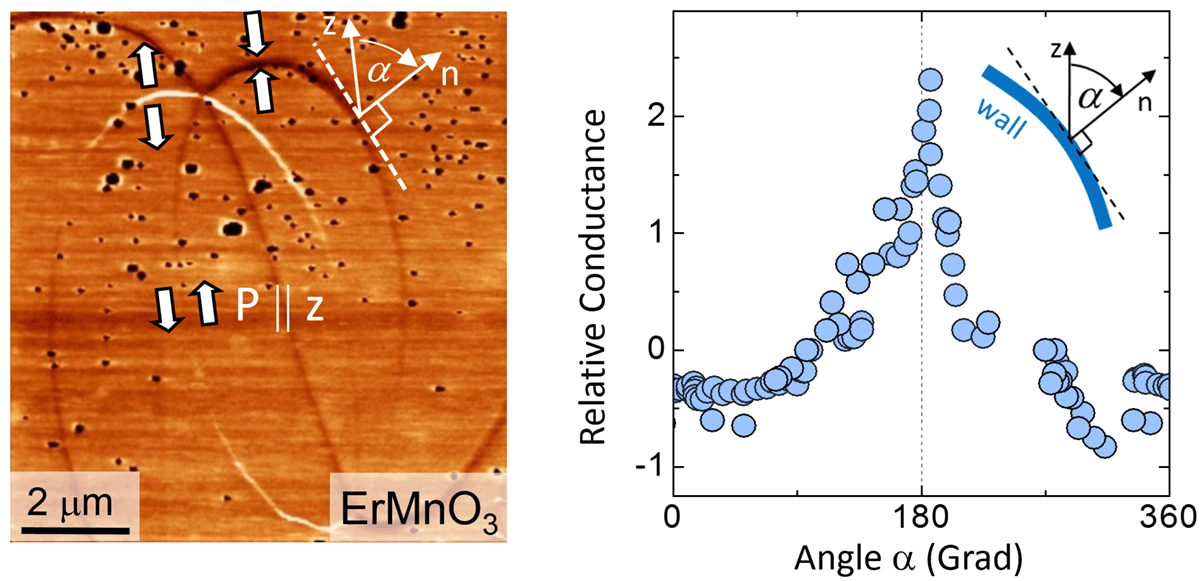Dennis Meier Receives Gustav-Hertz-Preis 2017
Multiferroics couple magnetic and electric properties in unique ways. By directing his research at ETH Zurich on the domain walls that separate regions with a different orientation of magnetic and electric order in multiferroics, Dennis Meier discovered a realm of novel magneto-electronic functionalities. For this discovery, he received the Gustav-Hertz Prize of the German Physical Society.
Interfaces are extremely useful because by connecting different types of materials they can develop properties that none of the materials themselves can display. A transistor, for example, switches an electrical current on or off via the electrical processes occurring at the interface between the semiconducting transistor constituents.
In materials with magnetic or electric order, a very special type of interface can occur, namely a domain wall. Domain walls separate regions with different orientation of the magnetic or electric order. They occur naturally, and in contrast to artificially grown interfaces, which reside as the growth has been completed, domain walls can be generated, deleted or moved at will any time. Because of this additional degree of freedom, domain walls hold great promise as "active" 2D materials for next-generation nanoelectronics.
Dennis Meier explored domain walls in multiferroics, that is, materials where magnetic and electric order occur simultaneously. In multiferroics, magnetic and electric properties are exceptionally strongly coupled up to the point that magnetic order may be controlled by energy-saving electric instead of magnetic fields.
With his research, Dennis Meier thus united three powerful concepts: multiferroics as host of pronounced magneto-electronic interactions, interfaces as host of novel inter-constituent phenomena and domain walls as novel type of mobile active interface. He discovered exotic electronic properties that arise at so-called improper ferroelectric domain walls. By advancing and combining different experimental microscopy techniques, he gained novel insight into these walls and characterized them with unprecedented completeness. In particular, he successfully demonstrated how local domain walls states can be adjusted and fine-tuned on demand, involving the domain wall orientation, magnetic fields and chemical doping as control parameters. His work presents domain walls in multiferroics as novel and versatile form of oxide interface of great academic and technological interest.
Dennis Meier studied physics at the University of Cologne, Germany, and received his PhD from the University of Bonn in 2010, honored with the Dissertation Award of Stiftung für Physik und Astronomie in Bonn. Afterwards, he worked as Feodor Lynen-Fellow of the Alexander von Humboldt Foundation at the UC Berkeley, where made his first domain wall related discoveries. Between 2013 and 2016, Dennis Meier led a Junior Research Team at the ETH Zurich, where he established the work now awarded with the Gustav Hertz Prize. He received his Habilitation at ETH in 2015. In 2016 he became Associate Professor and Onsager Fellow at the Institute for Materials Science and Engineering at NTNU Trondheim in Norway.
Links
- external pageProf. Dennis Meiercall_made
- external pageGustav Hertz Prizecall_made
- Laboratory of Multifunctional Ferroic Materials
- external pageAnisotropic conductance at improper ferroelectric domain walls, D. Meier, J. Seidel, A. Cano, K. Delaney, Y. Kumagai, M. Mostovoy, N. A. Spaldin, R. Ramesh, and M. Fiebig, Nature Mater. 11, 284 (2012)call_made
- external pageFunctional electronic inversion layers at ferroelectric domain walls, J. Mundy, J. Schaab, Y. Kumagai, A. Cano, M. Stengel, I. P. Krug, D. M. Gottlob, H. Doganay, M. E. Holtz, R. Held, Z. Yan, E. Bourret, C. M. Schneider, D. G. Schlom, D. A. Muller, R. Ramesh, N. A. Spaldin, and D. Meier, Nature Materials doi:10.1038/nmat4878 (2017)call_made
- external pageFunctional multiferroic domain walls in multiferroics (invited topical review), D. Meier, J. Phys.: Condens. Matter 27, 463003 (2015)call_made

